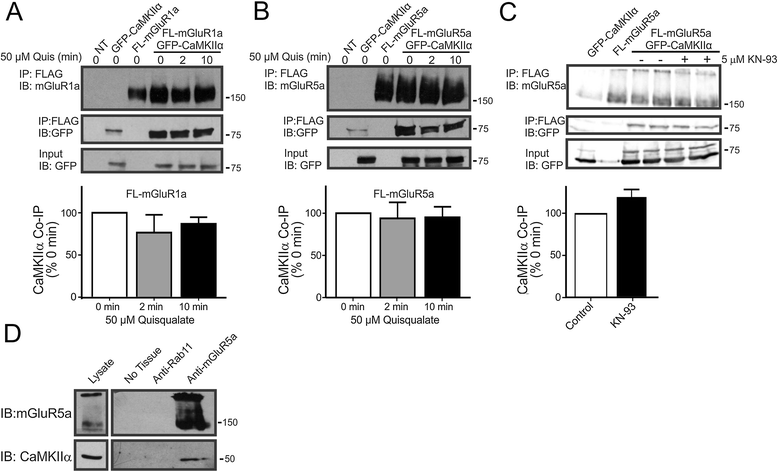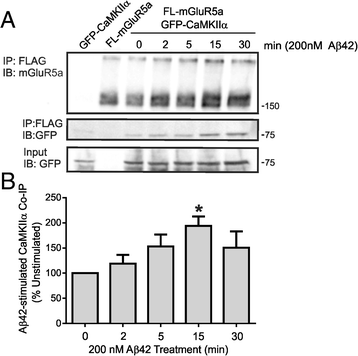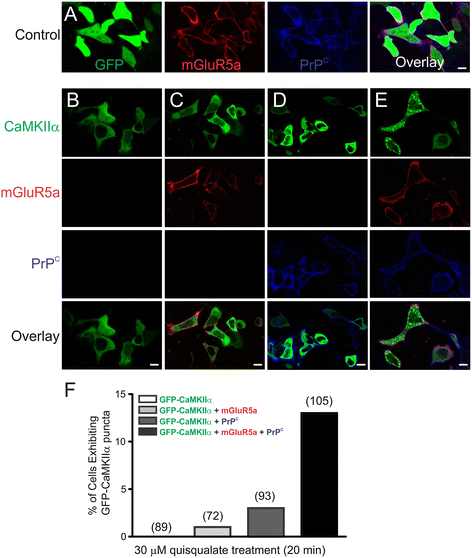Ca(2+)/calmodulin-dependent protein kinase II interacts with group I metabotropic glutamate and facilitates receptor endocytosis and ERK1/2 signaling: role of β-amyloid
- PMID: 25885040
- PMCID: PMC4378271
- DOI: 10.1186/s13041-015-0111-4
Ca(2+)/calmodulin-dependent protein kinase II interacts with group I metabotropic glutamate and facilitates receptor endocytosis and ERK1/2 signaling: role of β-amyloid
Abstract
Background: Agonist stimulation of Group I metabotropic glutamate receptors (mGluRs) initiates their coupling to the heterotrimeric G protein, Gαq/11, resulting in the activation of phospholipase C, the release of Ca(2+) from intracellular stores and the subsequent activation of protein kinase C. However, it is now recognized that mGluR5a also functions as a receptor for cellular prion protein (PrP(C)) and β-amyloid peptide (Aβ42) oligomers to facilitate intracellular signaling via the resulting protein complex. Intracellular mGluR5a signaling is also regulated by its association with a wide variety of intracellular regulation proteins.
Results: In the present study, we utilized mass spectroscopy to identify calmodulin kinase IIα (CaMKIIα) as a protein that interacts with the second intracellular loop domain of mGluR5. We show that CaMKIIα interacts with both mGluR1a and mGluR5a in an agonist-independent manner and is co-immunoprecipitated with mGluR5a from hippocampal mouse brain. CaMKIIα positively regulates both mGluR1a and mGluR5a endocytosis, but selectively attenuates mGluR5a but not mGluR1a-stimulated ERK1/2 phosphorylation in a kinase activity-dependent manner. We also find that Aβ42 oligomers stimulate the association of CaMKIIα with mGluR5a and activate ERK1/2 in an mGluR5a-dependent manner. However, Aβ42 oligomer-stimulated ERK1/2 phosphorylation is not regulated by mGluR5a/CaMKIIα interactions suggesting that agonist and Aβ42 oligomers stabilize distinct mGluR5a activation states that are differentially regulated by CaMKIIα. The expression of both mGluR5a and PrP(C) together, but not alone resulted in the agonist-stimulated subcellular distribution of CaMKIIα into cytoplasmic puncta.
Conclusions: Taken together these results indicate that CaMKIIα selectively regulates mGluR1a and mGluR5a ERK1/2 signaling. As mGluR5 and CaMKIIα are involved in learning and memory and Aβ and mGluR5 are implicated in Alzheimer's disease, results of these studies could provide insight into potential pharmacological targets for treatment of Alzheimer's disease.
Figures







References
-
- Ferguson SSG. Evolving concepts in G protein-coupled receptor endocytosis: the role in receptor desensitization and signaling. Pharmacol Rev. 2001;53:1–24. - PubMed
Publication types
MeSH terms
Substances
Grants and funding
LinkOut - more resources
Full Text Sources
Other Literature Sources
Research Materials
Miscellaneous

